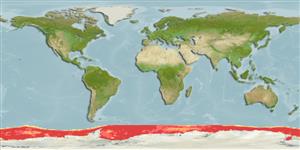Classification / Names
Common names from other countries
Main reference
Size / Weight / Age
Max length : 25.0 cm TL male/unsexed; (Ref. 5179); common length : 15.0 cm TL male/unsexed; (Ref. 2121); max. published weight: 200.00 g (Ref. 6390); max. reported age: 20 years (Ref. 5216)
Length at first maturity
Lm ?, range 13 - ? cm
Environment
Marine; pelagic-oceanic; depth range 0 - 728 m (Ref. 11892)
Climate / Range
Polar; ? - 2°C (Ref. 6390), preferred -2°C (Ref. 107945); 60°S - 78°S
Distribution
Southern Ocean: Antarctic Peninsula, South Shetland, Elephant, South Orkney islands, Weddell, Bellingshausen, Ross and Davis seas, Oates, Adélie, Wilhelm and other coasts of East Antarctica to Prydz Bay.
Countries | FAO areas | Ecosystems | Occurrences | Introductions
Short description
Dorsal
spines
(total): 6 - 8;
Dorsal
soft rays
(total): 35-38;
Anal
spines: 0;
Anal
soft rays: 36 - 39;
Vertebrae: 52 - 56. Pre-opercular-mandibular canal pores 9 (rarely 10), with 3 (rarely 4) on the mandible. Infraorbital canal with 4+2 pores; lateral line organs (neuromasts) present exposed region between the canal segments, the normal number probably being 4 (rarely 5), but some or all are often missing. Supraorbital canal with 3+1 pores (a second, more posterior pore rarely present in postero-dorsal section); between these 2 supraorbital canal segments is a trough divided by 3 low transverse ridges into 4 shallow depressions; on each ridge is a neuromasts organ. Temporal canal with 1+4 pores; between the 2 segment lies a single exposed neuromast. Supratemporal canal with 1+1 pores; no traces of neuromasts were found in the intervening regions.
Color: In life, pink with a silvery hue, the dorsal surface slightly darker. All fins pale, with clear hyaline membranes. The body becomes silvery with a darker dorsum only after death (Ref. 28937).
IUCN Red List Status (Ref. 115185)
Threat to humans
Harmless
Human uses
Fisheries: minor commercial
Tools
Special reports
Download XML
Internet sources
Estimates of some properties based on models
Phylogenetic diversity index
PD50 = 1.0000 many relatives (e.g. carps) 0.5 - 2.0 few relatives (e.g. lungfishes)
Trophic Level
3.2 ±0.3 se; Based on diet studies.
Resilience
Low, minimum population doubling time 4.5 - 14 years (K=0.14; tm=3-4; tmax=20; Fec=4,000)
Vulnerability
Moderate to high vulnerability (52 of 100)
Price category
